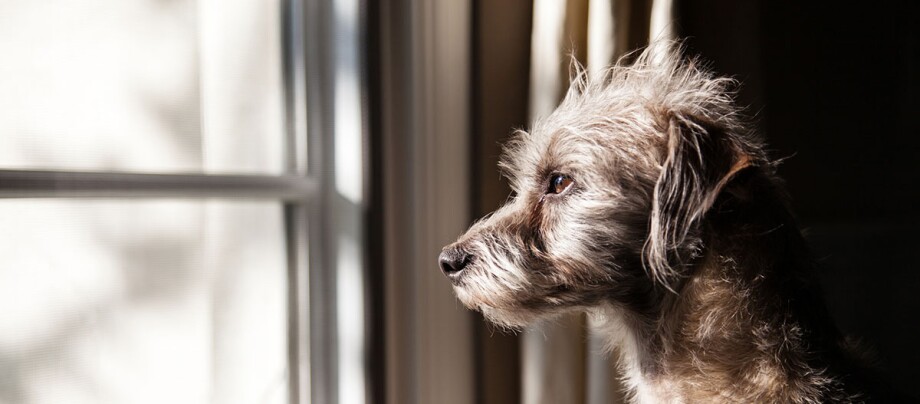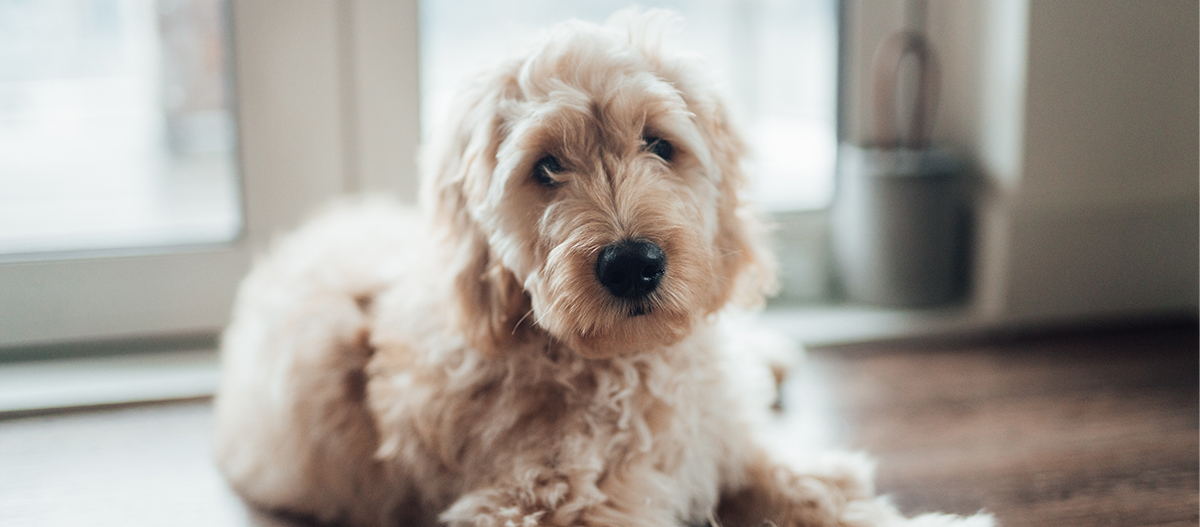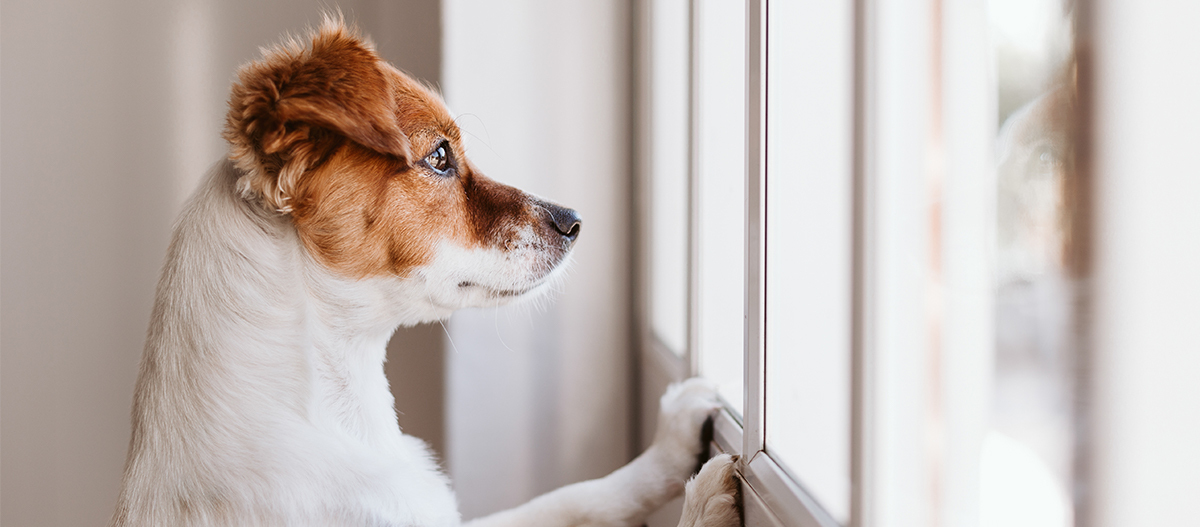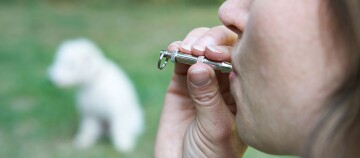Leaving Your Dog Alone – Separation Anxiety and Loss of Control
07.10.2022 - Reading time: 7 minutes

Dogs are pack animals. They do not like to be alone. The anxiety of being left behind is in their nature and some suffer from it more than others. But dogs can also learn up to an old age how to be alone. For puppies it is relatively easy, for older dogs this requires training and, if necessary, some patience. Read on to find out how your dog can learn to be alone for a few hours and what else you should know on the subject!
- Why dogs do not like to be alone
- Leaving your dog alone: how long is reasonable?
- Two basic types: separation anxiety or loss of control?
- Practise early: start training as puppies
- Training your dog to be left alone: adult dogs can learn, too
- Useful exercises: training your dog to be left alone
- Tips for leaving your dog at home alone without the stress
Dogs do not like to be left alone. The worry of being left behind is in their nature as pack animals and some suffer from it more than others. Sometimes, however, it can’t be helped: whether for work, occasions where your four-legged friend is unable to come with you, but also short waits in the car, are situations in which the animal needs to spend some time without their human.
The good news: up to old age, dogs can learn how to be alone. For puppies this is comparatively easy, for older dogs this may require training and patience. Read on to find out how your dog can learn to be left alone for a few hours.
Why dogs do not like to be alone
The anxiety of being alone and being left sits deep in every dog. Dogs are pack animals, even if nowadays they are no longer kept in dog packs. However, their social behaviour and feeling of belonging are very strong. In a pack, as for example with wolves or wild dogs, weak or ill animals are left behind and, in the worst case, die.
It’s hardly surprising if our dogs are always concerned about holding the connection to their “family”. But here, too, exceptions confirm the rule: working dogs who carry out a clear task are quite able to be alone for longer. It would really be most appropriate if our dogs could stay either in a pack of dogs or with their people.

Leaving your dog alone: how long is reasonable?
Unfortunately there is no clever answer to this question, as dogs are – just like humans – unique individuals. Some start to howl when their human shuts the door behind them, others become unsettled after an hour and start to run around the room, bite at furniture and objects or do their business in the home out of protest. Very sensitive dogs can even suffer from depression if they are often left alone or if they are left alone for too long.
Other dogs can be left alone for four or five hours without their humans, and with no separation anxiety at all. It shouldn’t be more than this in any case as your dog will have to relieve themselves at least at this point!
Anyone who leaves their four-legged friend alone every day while at work should look for a permanent dog sitter. It would be even better if you could take your four-legged friend to work with you. Many companies allow dogs in the workplace under certain conditions – just ask!
Two basic types: separation anxiety or loss of control?
Dogs that are anxious about being left alone can be categorised into two different types:
- Some have separation anxiety,
- others suffer from a loss of control.
With separation anxiety, it is actually the being along that gives the dog anxiety. As a dog owner you are taking on the role of alpha dog that confidently has the situation under control, decides what needs to be done and is responsible for the safety of the pack. The dog relies on you and is calm so long as this set-up works. For less relaxed dogs when their human disappears it is a serious disaster, even when just for a short time. Suddenly the alpha dog has gone and the sense of basic trust is shattered.
The most common reason for separation anxiety in dogs
Symptoms of separation anxiety & loss of control
Whether the reasons for the dog’s separation anxiety is a bad experience with previous owners or from their time as a puppy, it is justified and understandable. But often the behaviour of the human plays a central role. We unknowingly give the animal the feeling that a separation is something of great significance. If the mood of parting is intensified through lots of tender loving care and comfort, the dogs tension increases. If the pack leader actually leaves the home, the dog resorts to the activities mentioned above.
For dogs who feel a loss of control, on the other hand, it is the worry or even anger that you, as their “pack”, have left and they are not able to look after you. They feel it’s their task, and now they can’t carry it out.
If your dog is one of these types of dog, the hierarchy in the pack is to be set up in such a way as to clearly show him that you are the number one in the pack. He must accept that you are the leader and you yourself decide when you come and go. Periods of absence must be seen as natural for every day life.
A dog who suffers from loss of control needs to learn how not to feel responsible for their human, only then will they accept being alone at some point. Check when you can where your dog lays. Is it directly by the door to the house or high up on the couch? This is a clear signal that they believe it is their job to have everything under control in the house. Moving this resting place to less exposed areas of the house can sometimes help with this.

Practise early: start training as puppies
If your got is still a puppy, it is simple to teach them how to be alone. You can practise leaving the dog alone: young dogs can easily set their internal clock to our rhythm of life. The earlier the little one learns that being alone is part of every day life, the easier it will be for you to leave them alone without a lot of drama.
Read more on this in the special advice from Maxi Zoo “Leaving puppies alone”.
Training your dog to be left alone: adult dogs can learn, too
It can happen that adult dogs need to learn how to be alone again, perhaps because they have been adopted, perhaps because their owners are in a new life situation. Good to know: even grown animals are capable of learning too – it is possible for your dog to overcome separation anxiety.
Training for an adult dog with separation anxiety starts by engaging with them intensively before you leave the home. Play search games with them or go for a long walk. Searching games or agility training are exhausting for the dog in a positive way and most dogs appear to enjoy it. In this way, you are wearing your dog out in the appropriate way before leaving them alone.
Useful exercises: training your dog to be left alone
- Direct your dog first to their favourite spot and engage with him, for example with a toy or chew bone.
- While he is busy with that and not paying attention to you, leave the room.
- Then listen for whether your dog starts to howl or whimper.
- After a few minutes you can return to the room and reward your dog with a treat. This should get your dog to associate waiting and your return with something positive.
Train your dog every day. Increase the time of separation each time if you think that your dog has stayed calm and relaxed. Perhaps after a few days of practice you will already be able to do the shopping in your neighbourhood. Be sure to remember to reward your four-legged friend with a tasty surprise during the acclimation period.
It doesn’t happen so quickly with all dogs. Remain patient and consistent: do not return to the room if your dog is howling or whimpering. Otherwise your dog may associate their howling with your return and then wail longer and louder in the future.
Even if your dog needs a little longer before they are able to be left alone: don’t despair and scold your dog, but also don’t pamper them. With consistent, daily exercises it will be easier for your dog to be alone, not least also because this teaches them to trust you. Instead of whining, they will then happily wait for you and get their small reward.
Our tip:
Don’t make a big fuss when leaving the home. Casually say goodbye to your dog and when coming home, greet them with a lot of attention, but only after a few minutes!


